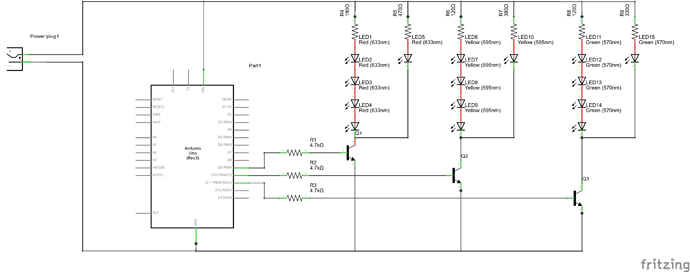Yes, it's perfectly acceptable to use paper and pencil, and take a picture of it to post it. Just like I've made a few edits to your diagram, and it was much faster to just print it, write on it, and take a photo, rather than try to edit it on the computer. (When I started learning electronics and drawing schematics, there were no computers and I did everything with pencil and paper -- OK, computers existed but they cost millions of dollars and took up whole rooms, nobody had one at home.) Please forgive the colors on the photo - I took the picture in front of window with a desk lamp on at the same time, and I guess my phone couldn't figure out the color balance with the simultaneous daylight and incandescent lighting.
The edits I made are simple: remove one of the horizontal supply rails and pull everything off of the one rail (makes it easier to read) and adding TWO supply wires to the Arduino (positive and ground.) You can't describe both signals with one line (even if the two conductors are in one cable.) The other edit I would do just to make it a little cleaner and follow convention is to move the bottom ground rail all the way to the bottom of the page, below the traces going between the Arduino and transistors.
We're getting to the point where it should work. But we can do some optimization. Let's look at the two red channels:
- R1, L1, L2, L3, L4: 12V supply, 4 x 2.0V diode drops, and 180 ohms. That's 22 mA
- R2, L5: 12V supply, 1 x 2.0V diode drop, and 470 ohms. That's 21 mA
Together, that's 43 mA, which is well within the current range of just about any transistor out there. There's no need for two transistors, it's just a waste of a transistor and resistor. So you can eliminate Q2, Q4, Q6, and R10, R9, and R8. Connect the signal that did go to the collector of the eliminated transistor, and hook it to the collector of its remaining mate.
While pencil and paper work just fine, there are several good free schematic editors out there. One that is becoming very popular with hobbyists is Fritzing: http://www.fritzing.org
Using Fritzing, I was able to throw together the attached in a few minutes (I would've still sketched it out on paper first.) This is only the second time I used Fritzing, so it took me a bit of a learning curve. One nice thing about Fritzing is that besides a schematic view, you can make pictorial and board layout views as well, all from the same initial drawing.
The general layout I followed is power at the top, ground at the bottom, with conventional current flowing down. The general flow of control signals is left to right.



